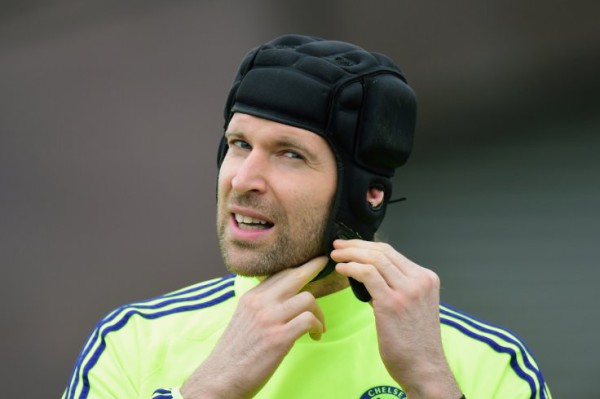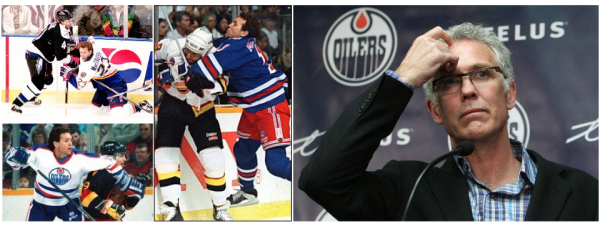“When you wake up in the morning
And the light hurts your head
The first thing you do
When you get up out of bed
Is hit the streets a-runnin’
And try to beat the masses
And go get yourself some cheap sunglasses.”–Gibbons/Hill/Beard
Concussion is certainly more serious than a hangover even though some symptoms are similar. Nor am I saying that globally there are tens of thousands preteen Georgie Bests and Gazzas being chauffered around by misguided mothers desperate to fill their prodigies’ bottomless legs on weekday evenings and Saturday or Sunday mornings. Maybe in County Tipperary if Stretty News’ fearless leader is not the exception he claims but otherwise no, definitely not. Yet it remains that serious debate has been raised on both sides of the Atlantic with the news youth soccer programs in America intend to outlaw heading the ball.
In the UK and Europe the notion heading is part of the game and a minimal risk can be understood due to comparatively less experience with concussion phenomena. On this side of the ocean, however, we should know it’s a ridiculous position to take. There is overwhelming evidence concussions sustained in athletic competition can lead to permanent brain damage. The suicides of National Football League players like Junior Seau, whose family the NFL callously prevented from speaking at his posthumous induction into the Football Hall of Fame in order to suppress any criticism of the league’s treatment (or lack thereof) of retired players suffering from chronic traumatic encephalopathy (CTE), Mike Webster, who died homeless on the street with dementia, and Jovan Belcher, who fatally shot his girlfriend, his three-month-old daughter’s mother, before driving to the Kansas City’s Chiefs’ training facility and turning the gun on himself in front of the team’s general manager, head coach, and linebackers coach, then was diagnosed with CTE during autopsy, should be sufficient as cautionary tales but they are the tip of the iceberg.
While the NFL is by court order renegotiating an inadequate settlement with its affected alumni, the National Hockey League is currently fighting litigation from its retired players who have suffered permanent brain damage, if–so far at least– with less dramatic consequences. Accusations the NHL is intimidating potential litigants by threatening their income from team-sponsored alumni appearances have surfaced in that bitter encounter.
Closer to home, Taylor Twellman, one of Major League Soccer’s most prolific strikers was forced into premature retirement after suffering several concussions. He is now the main in-game pundit for ESPN’s MLS coverage and an outspoken champion for establishing concussion protocols during matches. But perhaps most germane to the notion of protecting children by removing heading from the youth game is former boxing great Muhammad Ali. The once effervescent showman who incorporated beat poetry and activism into his public image is now in the late stages of Parkinson’s Disease, his muscular control almost gone, and his voice reduced to a whisper from the cumulative blows to the head, especially from three brutal fights with Joe Frazier, another in which he absorbed punches for almost eight rounds using his patented “rope-a-dope” technique before knocking out George Foreman, and an ill-advised final fight against his ruthless, methodical, former sparring partner Larry Holmes.
A fully inflated football may not be as dense as a bare fist but it comes much closer to one encased in a boxing glove. There is also the inevitable head-on-head collision to consider. The severity of such blows to an undeveloped cranium is not scientifically documented. Yet only a fool would dismiss the potential damage to their children, or anyone else’s, for the sake of their future entertainment. Claiming heading is a required skill in young players’ development is also a spurious notion. Both Hockey Canada and USA Hockey have banned checking (deliberate body-to-body contact) for decades and the quality of the professional game has not suffered. Surely fifteen and sixteen-year-old footballers can learn to head the ball as adeptly as their junior hockey counterparts adapt to a more physical game?
Former Chelsea-now Arsenal goalkeeper Petr Cech is a weekly reminder to Premier League fans of the game’s dangers. He continues to wear a padded helmet since suffering a depressed skull fracture followed by intense headaches after a knee-on-head collision with Reading’s Stephen Hunt in 2006. He also has no recollection of the collision to this day. That I can believe. Despite suffering only minor head injuries in my recent hit-and-run I couldn’t tell you anything about the episode other than I woke up two weeks later in hospital. The mind wisely protects you from such trauma. In line with concussion protocol Cech was out for three months. That’s the thing about brain injury. Unlike Luke Shaw’s double leg break–another condition with which my mishap has left me very familiar–you cannot exercise or otherwise rehabilitate the injury. Being encased in the skull and therefore inaccessible, waiting in a dark, silent room is pretty much all that can be done to aid the brain’s healing process. Again, waiting to see if all their faculties return without side affect or permanent limitation is surely not something to which anyone would wish to subject a child.

Cech is virtually the only professional footballer on the planet to permanently wear such headgear. Others occasionally do immediately after an injury but typically discard the padded helmet when they feel fully recovered. I say feel because, as Taylor Twellman, prematurely retired NHLer Eric Lindros, and a line of former gridiron and hockey greats that would rival the queue for the Who’s fifty-seventh farewell concert can attest, destroyed brain cells do not regenerate and, as with diseases like pneumonia, the brain becomes increasingly susceptible to greater damage with each repeated incident.
Despite that, and increasingly frequent head-to-head collisions in the game, I don’t think headgear should be mandated. It does deaden the ball’s impact but doesn’t provide anything close to full protection. Even the NFL is finding its helmets do almost nothing to prevent the brain form rattling around inside the skull upon impact. Therefore mandating softly padded headgear in proper football would take away an important element which makes the game more three-dimensional while offering extremely limited benefit. Show me a more effective model that provides protection without radically changing the sport and I’m on board.
Meanwhile there are other options to encourage players to take more care and responsibility when entering 50-50 challenges. For instance, Top 14 rugby heavily penalizes players who clearly have a right to play the ball but can pull out of an impact with another, fully committed, vulnerable player. The theory is that adults, unlike children, have the maturity to recognize danger and act responsibly. Similarly, the NHL is severely cracking down on hits to the head and boarding incidents which cause injury with both fines and incrementally longer suspensions for repeat offenders. Under a strict salary cap as they are, more than one team has released a reckless player who leaves his side with a shortened bench due to continual disciplinary absences. Although discipline has yet to be fully effective, the threat to both players’ lucrative livelihoods and a club’s competitive capabilities has made progress in reducing the rate of head injuries.
As necessary as headgear is, its presence ironically has much to do with dangerous play. The problem was almost immediately evident in the NHL when the league mandated players wear helmets at the beginning of the 1980s. The rule was grandfathered in as many veterans were more concerned with comfort–or narcissism–than safety, but high sticks and hits to the head or from behind all increased as players assumed their helmeted opponents were ‘protected’. Reckless play continued to rise until the league finally acknowledged the danger in the last decade or so, and began to act. Combined with the increased size, body mass, and speed of players skating at rates equivalent to downtown traffic inside an inescapable, walled playing surface, preventable injuries became so frequent such action had to be taken.
Interestingly the last player to go helmetless, Craig MacTavish, who retired in 1997, apparently suffered no such injuries although his dismal decisions as general manager for the hapless Edmonton Oilers until last year might suggest otherwise. Were opponents aware he was especially vulnerable and therefore more careful in their approach? One would hope so, as one would hope some of the more callous players in football can be taught to respect their competition, be it through education or iron-fisted discipline.
Regardless of the time it takes the professional game to catch up with medical science, however, youth programs cannot afford to wait for what all amount to frivolous reasons. Our children are our future, and their lives are not something we should needlessly put at risk for purity’s sake.


